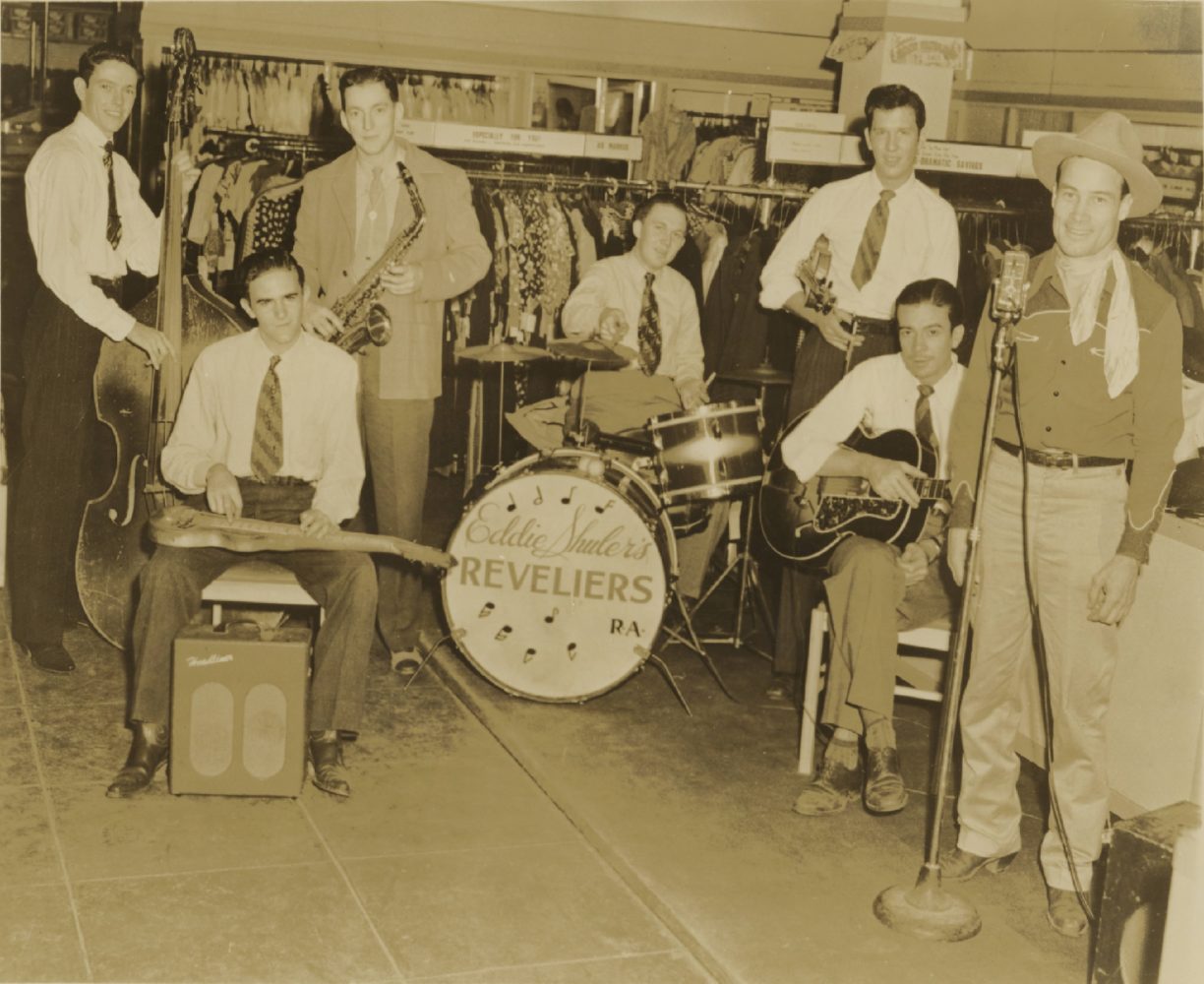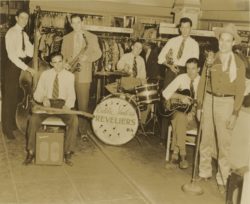Parish Spotlight
The Lake Charles Special
Record producer Eddie Shuler welcomed weirdness into Goldband Studio
Published: December 1, 2019
Last Updated: June 1, 2023

Southern Folklife Collection, Wilson Library, University of North Carolina at Chapel Hill
Eddie Shuler’s Reveliers, with Shuler at far right.
LeJeune wanted to cut records to further promote his music and secure dancehall gigs. Shuler had founded the label Goldband Records in 1945 to serve his own group, The All-Star Reveliers. He had no other clients. In a 1984 interview with Chris Strachwitz of the Arhoolie Foundation, Shuler recalled striking a deal with LeJeune: “I’ll put out one record on you and if it makes money, you and I are in business. If I don’t make no money, you’ll have to find somebody else.”
Shuler and LeJeune used the jingle cutter at another local radio station, KAOK, and bribed the engineer with whiskey for the acetate. Had LeJeune’s “Calcasieu Waltz” conformed to the line of recent jukebox hits bouncing between Louisiana and Texas, the Cajun would have struck up a sweet, fast fiddle and sung to his lady love, “Oh pretty girl, what am I going to do?” But with Shuler’s shrug of approval, LeJeune clutched his accordion close and held Amédé Ardoin’s memory closer. “Oh, jolie, comment moi je vas faire?” he keened into the microphone, updating Ardoin’s “La Valse de Amitiés.” With its b-side, “Lacassine Special,” the Folk–Star 78 was an unexpected hit. Cajun listeners, who actually didn’t want to be homogenized, loved the Cajun French, considering it a return to form. And virgin ears just loved Iry and his accordion.
“The first record I made seventy dollars, and I said, ‘Jesus Christ,’” Shuler told Strachwitz. “Back in those days, when people worked all day long for two dollars, that was a lot of money.”
Though he was a musician himself, perhaps Shuler’s greatest gift was patience. He’d learned from working with LeJeune that just because he didn’t understand an artist didn’t mean there wasn’t an audience. In 1954, he called again on liquor in the studio, this time to defuse tensions between Creole musician Boozoo Chavis and the R&B backing band who couldn’t cope with Boozoo’s aggressively negligent sense of rhythm. Half a jug into Seagram’s Seven, Boozoo tumbled off his stool—Shuler recalled the studio erupting into laughter—but he held onto his German button accordion, holding it high in the air as the last notes rang through the room. Shuler kept the take, employing an early use of fade-out to omit the clatter and hoots. It was the best take so far of “Paper in My Shoe,” now a zydeco standard.
Though he was a musician himself, perhaps Shuler’s greatest gift was patience. He’d learned from working with LeJeune that just because he didn’t understand an artist didn’t mean there wasn’t an audience.
In 2005, when Shuler died, Goldband was the country’s longest–standing independent record label. In its mid-century heyday, the label added strains of swamp pop and zydeco to America’s rock fervor. Shuler was well-placed in Lake Charles, where the post-war oil industry drew job seekers from rural environs. The world might have been assimilating outside, but in the Goldband studio, weird was welcome. Shuler catalogued Cajun excess and marketed it to the masses. He even helped competitors: in 1959, he lent local record shop owner George Khoury studio time for a haunting artist Khoury had a particular feeling about. “Come with me, my love,” Phil Phillips crooned on “Sea of Love,” co-written with Khoury, as bass vocals bullfrogged beneath him. The song didn’t immediately skyrocket, but one brash Baton Rouge DJ was entranced by the track; he barricaded himself in the studio and played “Sea of Love” on repeat. The song reached number two on the Billboard charts later that summer.
Goldband’s good reputation traveled far. In 1959, a thirteen-year-old girl rode thirty hours by bus, with her grandmother, to come cut her first record at Shuler’s Goldband Studios. She wanted to sing only of “Puppy Love,” and though Shuler was decades past Miss Dolly Parton’s teenage fluttering, he hit record anyway.
As a border town, Lake Charles was a blessing to Shuler, serving up a confluence of Cajuns and Western country folk, some of whom had instruments and some who just had record players. But the national appetite for regional music fell off in the late ’70s, with listeners devoting their hearts and hairstyles to disco instead. Though Shuler dabbled in country-and-western music—he was a Texas boy after all—Nashville proved too daunting a competitor, so he backed down. After his death, the Goldband complex—a church Shuler repurposed to house his studio, record shop, and television repair business—deteriorated, and was finally razed in 2017. The empty field at the intersection of Ryan and Church Streets is almost peaceful today, white noise from the highway the only soundscape. Why, you could be anywhere.
Writer and photographer Lucie Monk Carter is always proud to tell people she’s from Lake Charles.

This article is funded in part by a grant from the New Orleans Jazz & Heritage Foundation.
